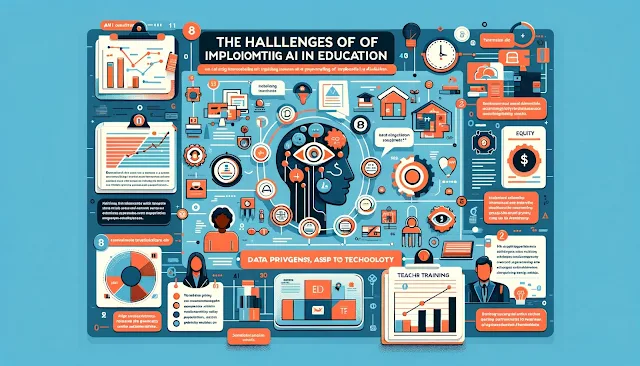Artificial Intelligence (AI) is poised to transform the education sector by enhancing teaching and learning experiences. This blog post explores the future of AI in education, its benefits, challenges, and real-world applications.
Understanding AI in Education
AI in education involves using intelligent systems to support teaching and learning. Key applications include:
- Personalized Learning: AI systems can tailor educational content to individual student needs.
- Automated Grading: AI can grade assignments and exams, providing immediate feedback.
- Adaptive Learning: AI can adjust the difficulty of content based on student performance.
 |
| Illustration of AI applications in education, including personalized learning and automated grading. |
Image Prompt: AI applications in education.
Key Benefits of AI in Education
AI offers several benefits in the education sector, such as:
- Improved Learning Outcomes: Personalized and adaptive learning can enhance student performance.
- Increased Efficiency: Automating administrative tasks allows educators to focus on teaching.
- Enhanced Engagement: Interactive and immersive AI tools can increase student engagement.
 |
| Infographic highlighting the benefits of AI in education, including improved learning outcomes and increased efficiency. |
Image Prompt: Benefits of AI in education.
Challenges of AI in Education
Despite its potential, implementing AI in education faces several challenges, including:
- Data Privacy: Ensuring the security and privacy of student data is critical.
- Equity and Access: Addressing disparities in access to AI tools and resources.
- Teacher Training: Providing educators with the skills and knowledge to effectively use AI tools.
 |
| Infographic outlining the challenges of implementing AI in education, including data privacy and equity. |
Image Prompt: Challenges of AI in education.
Real-World Applications of AI in Education
AI is being applied in various educational contexts, such as:
- Intelligent Tutoring Systems: AI-powered tutoring systems provide personalized support to students.
- Virtual Classrooms: AI enables interactive and engaging virtual learning environments.
- Learning Analytics: AI analyzes student data to provide insights and improve teaching strategies.
 |
| Examples of AI applications in education, including intelligent tutoring systems and virtual classrooms. |
Image Prompt: Applications of AI in education.
Future Trends in AI in Education
The future of AI in education involves several trends, including:
- AI-Driven Content Creation: AI tools for creating personalized educational content.
- Augmented Reality (AR): Combining AI with AR for immersive learning experiences.
- AI for Special Education: Developing AI tools to support students with special needs.
 |
| Illustration of future trends in AI in education, including AI-driven content creation and AR. |
Image Prompt: Future trends in AI in education.
Conclusion
AI has the potential to revolutionize education by providing personalized learning experiences, improving efficiency, and enhancing student engagement. By addressing challenges such as data privacy and equity, we can fully leverage AI to create a brighter future for education.
 |
| Graphic summarizing the potential and future of AI in education. |
SEO Keywords: AI in education, AI teaching, AI learning, AI education technology, AI classroom, AI in schools, AI student engagement, AI education benefits, AI education challenges, AI education trends, AI education future, AI education applications, AI education tools, AI education solutions, AI in higher education, AI in K-12, AI educational software, AI education innovation, AI education projects, AI education examples.

Comments
Post a Comment